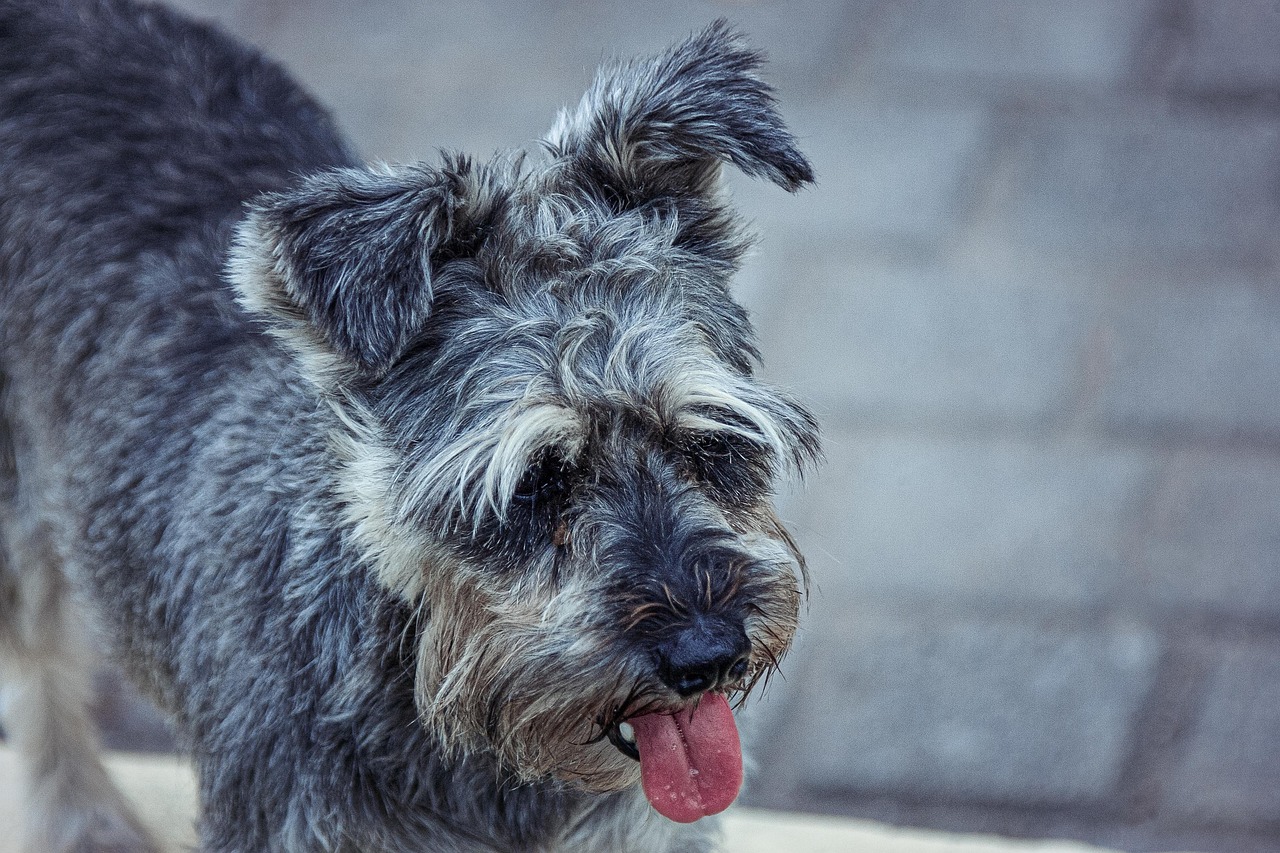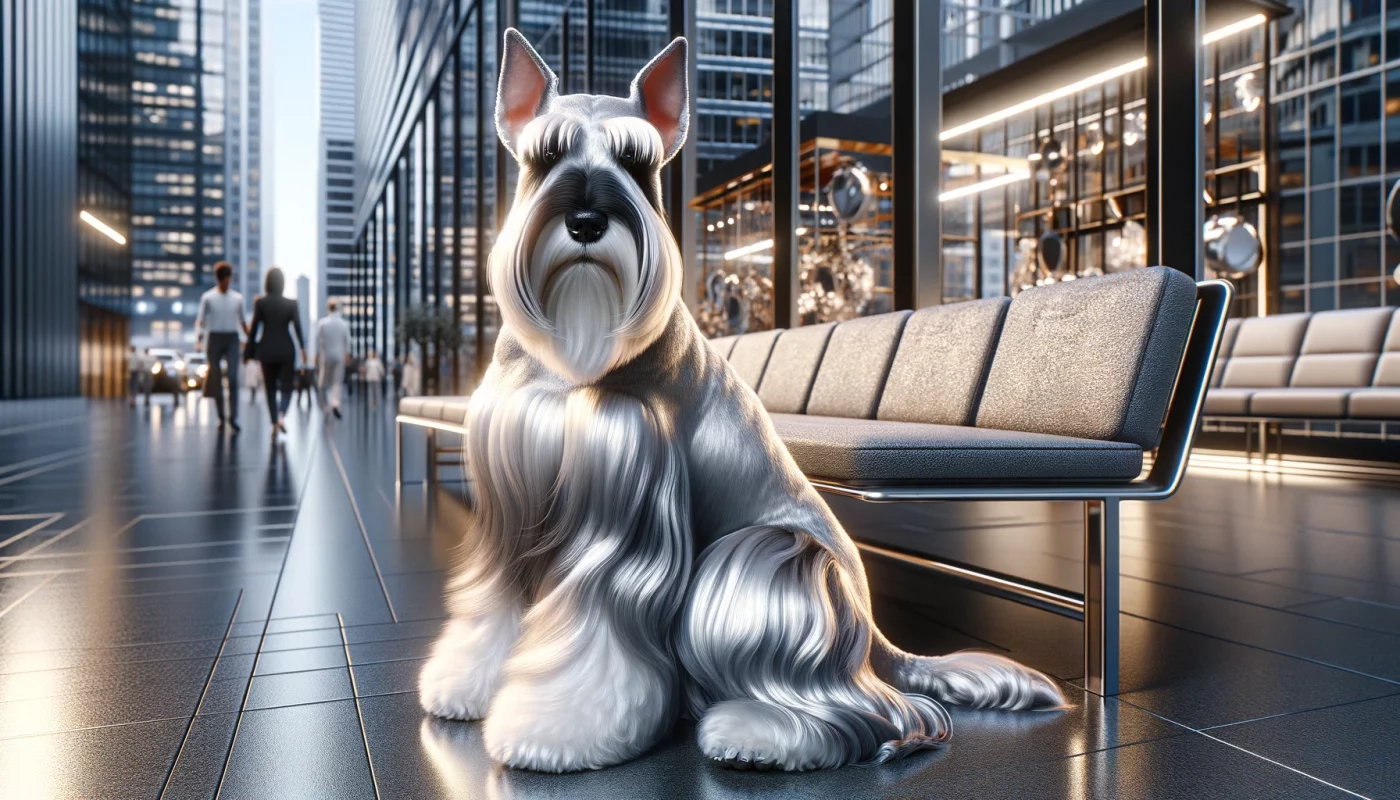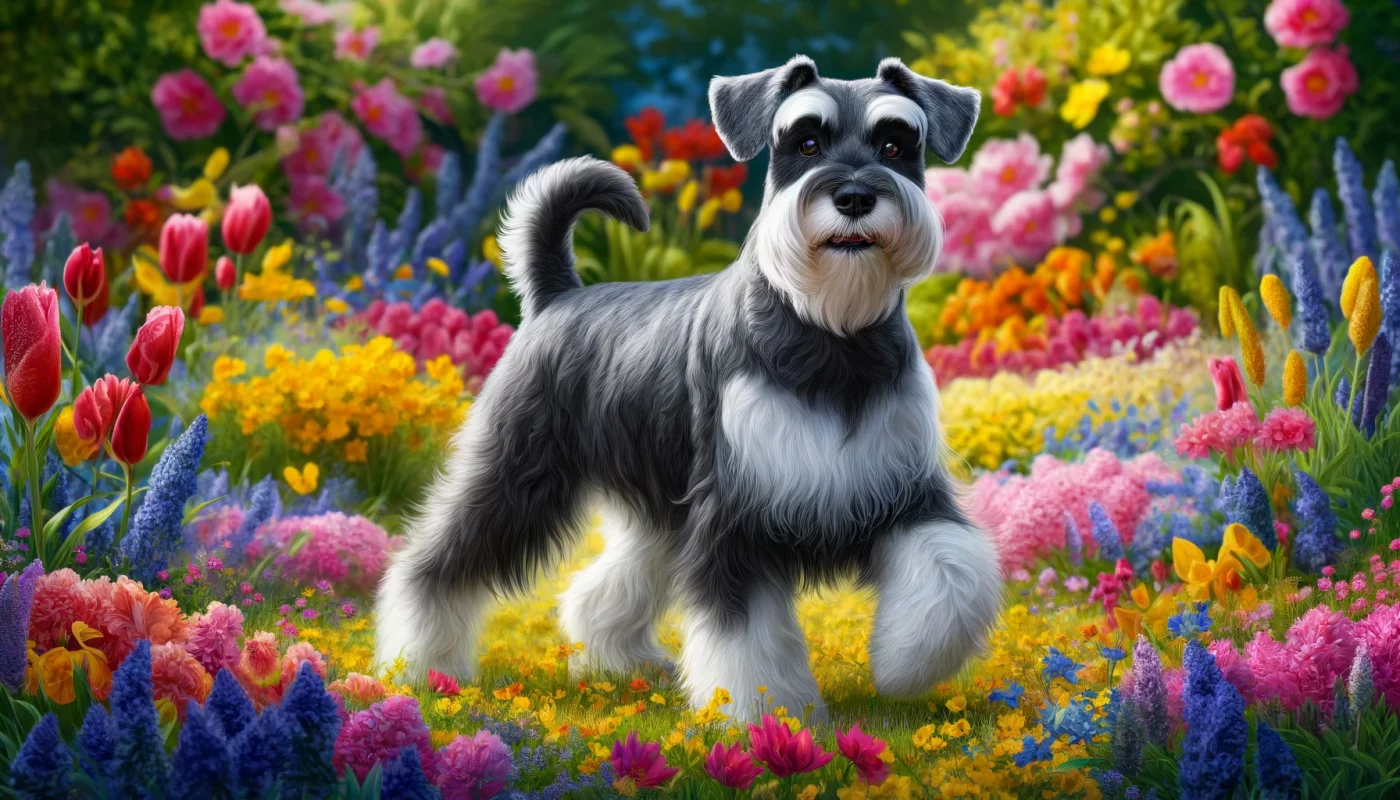Schnauzers, with their distinctive bearded snouts and expressive eyebrows, are a breed known not just for their spunky and watchful character but also for their variety of coat colors. Originating from Germany, Schnauzers come in three different sizes—Miniature, Standard, and Giant—each of which can sport a range of colors according to specific breed standards. These colors not only enhance the dog’s appearance but can also influence grooming needs and visibility in dog shows. The breed’s coat is wiry and dense, providing a perfect backdrop for its striking color variations which range from the traditional salt and pepper to more unique shades like pure white or black and silver. This article will explore seven stunning color variations of the Schnauzer, showcasing how these colors contribute to the breed’s allure and distinctive presence.
1. Salt and Pepper

The salt and pepper coloration is the most iconic and recognized shade among Schnauzers. This color features banded hairs, which give a blended gray effect and is achieved through a combination of black and white hairs mixed throughout the coat. The intensity of the gray can vary, creating a spectrum from light to dark shades. This pattern also includes a dark facial mask, enhancing the Schnauzer’s expressive face. The salt and pepper Schnauzer is prized for its traditional appearance and the way its coat highlights the robust, muscular build typical of the breed.
2. Black

Pure black Schnauzers have a sleek, uniform coat color that exudes elegance and boldness. Unlike the salt and pepper variety, black Schnauzers have a solid black color without any banding. Their dark coats provide a stunning contrast to their often-silver furnishings on the eyebrows, beard, and legs. Black Schnauzers can be particularly striking in appearance, making them popular choices for both dog shows and as a family pet. This color variation requires regular grooming to maintain the coat’s rich luster and to avoid dullness.
3. Black and Silver

The black and silver Schnauzer is another popular color variation, where the base of the coat is solid black with distinct silver markings on the eyebrows, beard, chest, and legs. This color pattern is similar to that of the black Schnauzer but with added flair due to the striking silver highlights. These markings should be clear and well-defined, contrasting sharply with the darker body color. The black and silver Schnauzer is often admired for its dramatic and regal appearance, which can be particularly eye-catching in competitive shows.
4. White

White Schnauzers are less common and are characterized by a pure, snowy coat. This color is not recognized in Standard and Giant Schnauzers but is an accepted color in Miniature Schnauzers. White Schnauzers require diligent grooming to keep their coats pristine and free from stains. While spectacular, the white coat can pose challenges, as it can easily show dirt and may require more frequent bathing.
5. Platinum Silver

Platinum silver Schnauzers are a rarer color variation that features a lighter, almost metallic silver coat. This stunning shade is usually seen in Miniature Schnauzers and is celebrated for its unique, eye-catching appearance. The platinum silver coat can shimmer beautifully in sunlight, providing an almost ethereal quality. Owners of platinum silver Schnauzers might find themselves frequently stopped by admirers, drawn to the uncommon beauty of the breed’s luxurious coat.
6. Chocolate (Liver)

Chocolate or liver-colored Schnauzers are quite rare and are a result of a recessive gene. This warm, deep brown color can vary in shade but always maintains a rich tonality that is different from the traditional black or gray Schnauzers. Chocolate Schnauzers often have matching brown eyes and noses, which can soften their overall expression compared to the more common darker colors.
7. Parti-Color

Parti-color Schnauzers features two colors, one of which must be white, distributed in a piebald pattern across the body. This variegation can include any of the other recognized colors and provides a unique, sometimes whimsical appearance. Parti-colored Schnauzers are especially rare and can stand out due to their distinctive patterns, which ensure no two dogs look exactly alike.
In conclusion, Schnauzers come in a delightful array of colors, each adding its unique touch to the breed’s already charismatic demeanor. From the classic salt and pepper to the rare chocolate and striking platinum silver, these colors highlight the versatility and beauty of the Schnauzer breed. Whether competing in dog shows or serving as loyal family companions, Schnauzers of all colors carry the breed’s trademark vigor and distinctiveness. The choice of color can influence grooming needs and aesthetic appeal, but all Schnauzers, regardless of their coat color, share the same robust health and vibrant personality that owners cherish.
Frequently Asked Questions About Schnauzer Colors
1. What is the most common color for Schnauzers?
The most common color for Schnauzers, particularly the Standard and Miniature varieties, is salt and pepper. This classic and iconic color features banded hairs that create a blended gray effect, appearing as intermixed shades of black and white. The salt and pepper Schnauzer showcases a natural, earthy look with a darker mask that enhances the dog’s expressive facial features. This coloration not only highlights the breed’s robust build but is also favored for its ability to hide dirt and debris better than lighter coats, making it practical as well as aesthetically pleasing.
2. Are white Schnauzers rare?
White Schnauzers are quite rare and are not recognized in the Standard or Giant Schnauzer varieties according to many kennel club standards. They are, however, recognized in the Miniature Schnauzer variety. White Schnauzers stand out due to their striking, pure snowy coat, which requires diligent grooming to maintain its pristine appearance. The rarity and maintenance needs make the white Schnauzer a less common sight, though they are cherished by those who own them for their unique and eye-catching appearance.
3. Can Schnauzers be black and silver?
Yes, black and silver is a recognized and popular coloration in Schnauzers, especially in the Miniature variety. This color pattern features a solid black base with elegant silver markings typically found on the eyebrows, beard, chest, and legs. The distinct contrast between the black and silver areas gives these Schnauzers a dramatic and attractive appearance, making them highly desirable in both show rings and as pets.
4. What does a platinum silver Schnauzer look like?
A platinum silver Schnauzer displays a shimmering, metallic-like coat that can be almost ethereal in its beauty. This lighter shade of gray often appears luminous and can vary from light silver to a near-white hue. Platinum silver Schnauzers are particularly striking under sunlight, where their coats can reflect light with a gleaming finish. This color is most commonly seen in the Miniature Schnauzer breed and is celebrated for its unique luster and rarity.
5. How common are chocolate or liver Schnauzers?
Chocolate or liver Schnauzers are quite uncommon. This color is a result of a recessive gene and features a rich, warm brown tone throughout the dog’s coat. Liver-colored Schnauzers also have brown noses, paw pads, and eye rims, which distinguish them from the more typical black or salt and pepper varieties. Due to the genetic specifics required to produce this color, chocolate Schnauzers are rarely seen but are prized for their unusual and distinctive appearance.
6. What are parti-color Schnauzers?
Parti-color Schnauzers have a coat that is predominantly white with patches of another color, such as black, silver, or gray. This unique color pattern is especially rare and is not recognized by all kennel clubs, particularly for Standard and Giant Schnauzers. In Miniature Schnauzers, however, parti-color can occur and is quite eye-catching due to the stark contrast between the white base and the darker patches.
7. Do the colors of a Schnauzer affect its personality?
No, the color of a Schnauzer does not affect its personality. Schnauzers, regardless of their coat color, typically share the same range of temperaments and behaviors characteristic of the breed. These include being alert, spirited, and loyal. Personality traits in Schnauzers are more influenced by genetics, upbringing, and training rather than the color of their coat.
8. Are there any health issues associated with certain Schnauzer colors?
In Schnauzers, there are no known health issues directly linked to coat color. However, white Schnauzers can sometimes be more susceptible to skin cancer and sunburn due to their lack of pigmentation, which requires owners to take additional precautions in sunny climates. As with any breed, genetic diversity and proper breeding practices are more influential in determining a dog’s health than coat color.
9. How does sunlight affect the color of a Schnauzer’s coat?
Sunlight can cause the color of a Schnauzer’s coat to fade, particularly for darker colors like black or chocolate. Continuous exposure to the sun can lighten these colors, giving them a bleached look. For Schnauzers with lighter colors, such as white or platinum silver, sunlight may not cause fading but can increase the risk of skin issues due to their sensitive skin.
10. Can Schnauzer puppies change color as they grow?
Yes, Schnauzer puppies can change color as they grow, particularly those born with darker coats. For example, black puppies may develop silver or gray hairs as they mature, and salt and pepper puppies can see a significant adjustment in the distribution of their banded hairs. Regular grooming and age can influence the final appearance of their coat color, which may stabilize as they reach adulthood.
 Toledo, United States.
Toledo, United States.